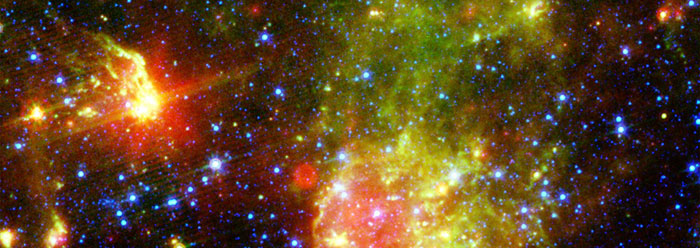If complicated living things arose through eons of evolution, and if lower rock layers represent the earth long ago before those eons occurred, then complicated life forms should only exist near the top―after evolution had enough time to accidentally develop them. But what would happen to belief in biological evolution if complicated life forms were among the fossils in the bottom layers?
Such is, in fact, the case here on earth. And now, a newly described cluster of galaxies appears to be the cosmological equivalent of biological "maturity" found where it should not exist, challenging stellar evolution in the same way that out-of-place "mature" life forms challenge biological evolution.
Since all phyla—the major categories of living forms—are represented in the famous Cambrian rock strata, complicated creatures appear suddenly and fully formed right at the bottom of the fossil record.1 This is incompatible with Darwin's now famous "tree of life" history diagram, which might more accurately reflect the fossil data if it were turned upside-down.2 But instead of questioning biological evolution, researchers have invoked miraculously rapid rates of evolutionary change to explain how these "mature" creatures could have formed so quickly.
Now, astronomers have uncovered a mature, more fully "evolved" cluster of galaxies in a segment of distant space that was thought to represent the early, immature universe.3 And the astronomers are waiting for the theoretical physicists to pull a rabbit out of their formulae that might insulate nature-only models of galaxy formation from such contradictory evidence.4
Using an X-ray telescope mounted in the European Space Agency's XMM-Newton satellite, ironically named after one the world's great creation scientists,5 astronomers published their accidental galactic cluster find in the journal Astronomy & Astrophysics. They wrote, "These properties imply that this structure could be the most distant, mature cluster known to date and that X-ray luminous, elliptical-dominated clusters are already forming at substantially earlier epochs than previously known."6
The galaxies in the cluster all look as though they had undergone eons of natural maturation. Raphael Gobat, lead researcher of the Astronomy & Astrophysics study, told Discovery News, "This is interesting because it puts a constraint on models of galaxy evolution. I would be interested to see how they can make the models fit both proto-clusters and this."7
Indeed, just as biological evolution required a special "accelerated evolution" add-on in order to accommodate the Cambrian "explosion" of life forms, more add-ons are anticipated to accommodate this newly discovered cluster of red galaxies into a naturalistic bias. Undoubtedly, those committed to a nature-only perspective to explain not only how the universe works but also how it originated will invent another "natural miracle" that will salvage their perspective from contradictory facts. http://www.icr.org/article/6025/
References
-
Vertebrates are even known in Cambrian rocks, and their
fossils look like today's living sea creatures. See Shu,
D.-G. et al. 1999. Lower Cambrian vertebrates from South
China. Nature. 402 (6757): 42-46. See also Shu,
D.-G. et al. 2003. Head and backbone of the Early
Cambrian vertebrate Haikouichthys.
Nature. 421 (6922): 526-529. - Thomas, B. and F. Sherwin. 2009. Darwin's Withering Tree of Life. Acts & Facts. 38 (5): 16.
- Skeptics often object when non-skeptics use the term "evolution" in the context of cosmology. But since naturalist cosmologists routinely refer to "stellar evolution" and the like, which is easily verifiable by running a Google Scholar search for the phrase, this objection is merely a hand-picked smokescreen.
- This is not the first report of an out-of-place galaxy. See Coppedge, D. 2006. Mature at Birth: Universe Discredits Evolution. Acts & Facts. 35 (10).
- Dao, C. 2008. Man of Science, Man of God: Isaac Newton. Acts & Facts. 37 (5): 8.
- Gobat, R. et al. 2011. A mature cluster with X-ray emission at z = 2.07. Astronomy & Astrophysics. 526: A133.
- Klotz, I. Oldest Galaxy Cluster Looks Like Modern-Day Kin. Discovery News. Posted on news.discovery.com March 9, 2011, accessed March 11, 2011.
* Mr. Thomas is Science Writer at the Institute for Creation Research.
